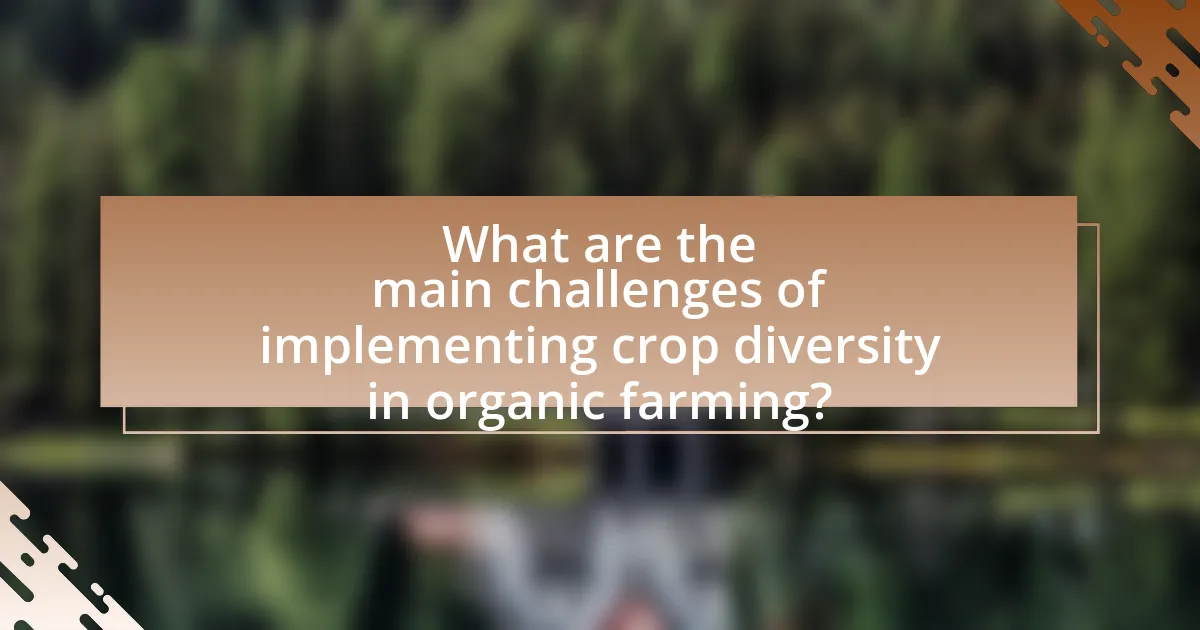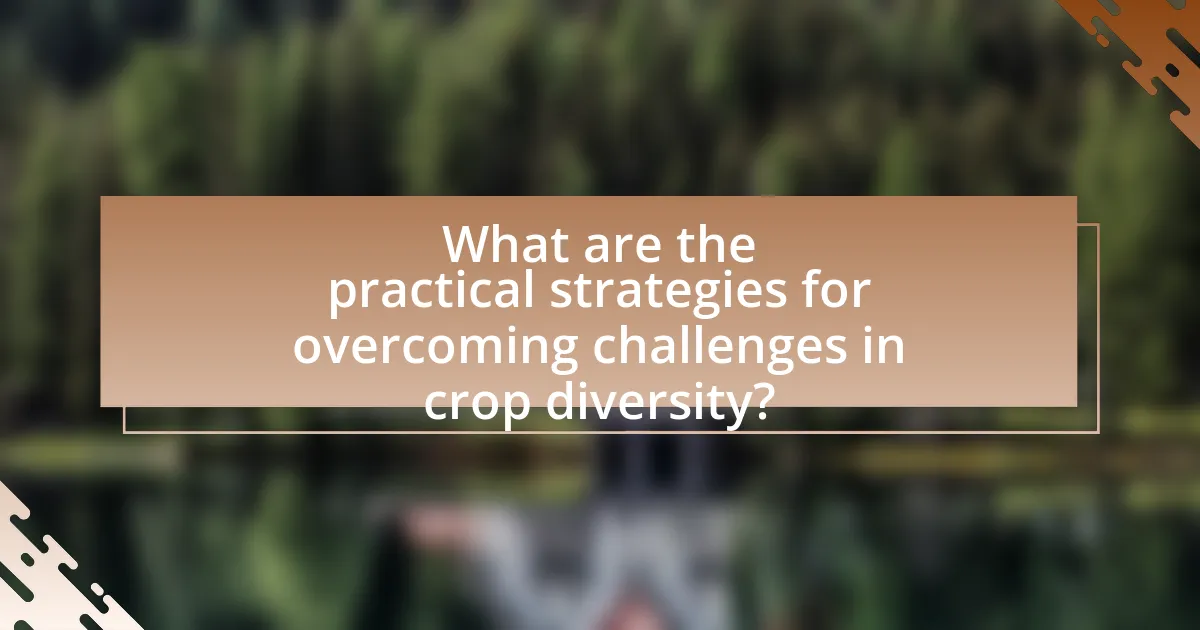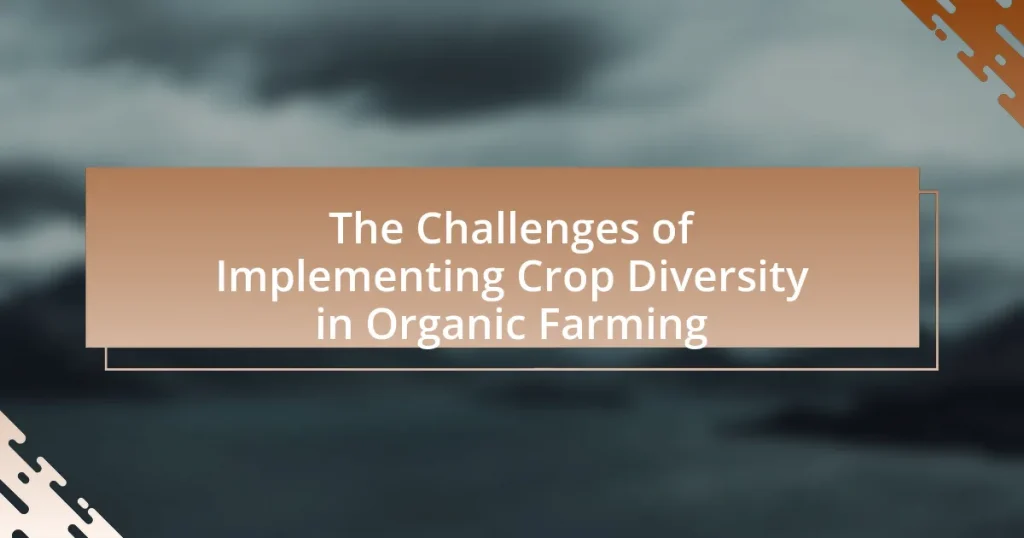The article examines the challenges of implementing crop diversity in organic farming, highlighting key issues such as limited access to diverse seed varieties, increased management complexity, and economic risks. It discusses how crop diversity can enhance organic farming practices by improving soil health, pest management, and ecosystem resilience, while also addressing specific challenges like resource competition and pest interactions. Additionally, the article explores the economic implications of crop diversity, including production costs and market access difficulties, and emphasizes the importance of government policies and community support in promoting diverse cropping systems. Practical strategies for overcoming these challenges, such as crop rotation and intercropping, are also outlined, providing insights into effective management of crop diversity in organic agriculture.

What are the main challenges of implementing crop diversity in organic farming?
The main challenges of implementing crop diversity in organic farming include limited access to diverse seed varieties, increased management complexity, and potential economic risks. Limited access to diverse seed varieties arises from regulatory restrictions and the dominance of commercial seed companies, which can hinder farmers’ ability to select appropriate crops for their specific environments. Increased management complexity occurs as farmers must develop new skills and knowledge to manage a wider range of crops, which can be resource-intensive. Economic risks are present because diversifying crops may lead to lower yields in the short term, impacting farmers’ income and financial stability. These challenges are supported by studies indicating that while crop diversity can enhance resilience and sustainability, the transition requires significant investment and adaptation efforts from farmers.
How does crop diversity impact organic farming practices?
Crop diversity significantly enhances organic farming practices by improving soil health, pest management, and overall ecosystem resilience. Diverse crops contribute to a more balanced nutrient profile in the soil, which is essential for organic farming that relies on natural inputs. Research indicates that farms with higher crop diversity can reduce the incidence of pests and diseases, as various plants can disrupt pest life cycles and attract beneficial insects. For instance, a study published in the journal “Agriculture, Ecosystems & Environment” found that diversified cropping systems can lead to a 30% reduction in pest populations compared to monocultures. Additionally, crop diversity promotes biodiversity, which is crucial for maintaining ecological balance and sustainability in organic farming systems.
What specific challenges arise from integrating diverse crops?
Integrating diverse crops presents specific challenges such as increased complexity in management, competition for resources, and potential pest and disease interactions. The complexity arises from the need to coordinate different planting and harvesting schedules, which can complicate labor and resource allocation. Additionally, diverse crops may compete for water, nutrients, and sunlight, potentially leading to reduced yields if not managed properly. Furthermore, the introduction of various crops can create new pest and disease dynamics, as some species may attract pests that do not affect others, complicating pest management strategies. These challenges necessitate careful planning and management to ensure successful integration of diverse crops in organic farming systems.
How does crop diversity influence pest management in organic farming?
Crop diversity significantly enhances pest management in organic farming by disrupting pest life cycles and promoting beneficial organisms. Diverse cropping systems create a variety of habitats that can attract natural predators and parasitoids, which help control pest populations. Research indicates that farms with higher crop diversity experience lower pest incidence due to the presence of multiple plant species that can confuse pests and reduce their ability to locate host plants. For instance, a study published in the journal “Agriculture, Ecosystems & Environment” found that polycultures can reduce pest abundance by up to 50% compared to monocultures. This evidence supports the assertion that crop diversity is a crucial strategy for effective pest management in organic farming.
Why is crop diversity important for sustainable agriculture?
Crop diversity is crucial for sustainable agriculture because it enhances ecosystem resilience, improves soil health, and increases food security. Diverse crops can better withstand pests, diseases, and climate fluctuations, reducing the need for chemical inputs and promoting natural pest control. Research indicates that farms with higher crop diversity can yield more stable outputs over time, as demonstrated in a study published in the journal “Nature” by Tilman et al. (2006), which found that biodiversity in agricultural systems leads to increased productivity and stability. This evidence underscores the importance of crop diversity in achieving sustainable agricultural practices.
What ecological benefits does crop diversity provide?
Crop diversity provides significant ecological benefits, including enhanced soil health, increased resilience to pests and diseases, and improved ecosystem services. Diverse cropping systems contribute to soil fertility through varied root structures and organic matter inputs, which enhance nutrient cycling and microbial activity. Additionally, a variety of crops can disrupt pest life cycles and reduce the likelihood of disease outbreaks, leading to lower reliance on chemical inputs. Research indicates that farms with higher crop diversity can support a wider range of beneficial organisms, such as pollinators and natural pest predators, which further bolsters ecosystem stability and productivity.
How does crop diversity contribute to soil health?
Crop diversity significantly enhances soil health by improving soil structure, increasing nutrient availability, and promoting beneficial microbial activity. Diverse root systems from various crops can penetrate different soil layers, which helps to aerate the soil and improve water infiltration. Additionally, different crops contribute various organic matter types to the soil, enriching it with nutrients and enhancing its fertility. Research indicates that fields with higher crop diversity can exhibit up to 30% greater soil organic carbon levels compared to monoculture systems, which directly correlates with improved soil health and resilience.

What are the economic challenges associated with crop diversity in organic farming?
The economic challenges associated with crop diversity in organic farming include increased production costs, market access difficulties, and price volatility. Increased production costs arise from the need for specialized equipment and labor to manage diverse crops effectively, which can strain financial resources. Market access difficulties occur because consumers and retailers often prefer uniform products, making it harder for farmers to sell diverse crops. Price volatility is a significant issue, as diverse crops may not have stable market prices, leading to unpredictable income for farmers. These challenges can hinder the adoption of crop diversity, despite its ecological benefits.
How do costs affect the adoption of crop diversity?
Costs significantly influence the adoption of crop diversity by impacting farmers’ financial decisions and resource allocation. High initial costs associated with diversifying crops, such as purchasing seeds, equipment, and implementing new farming practices, can deter farmers from adopting diverse cropping systems. For instance, a study by the Food and Agriculture Organization (FAO) indicates that farmers often prioritize short-term economic returns, leading them to favor monocultures that require less investment and management. Additionally, ongoing costs related to maintenance, pest management, and labor for diverse crops can further complicate the decision-making process, as farmers may perceive these expenses as risks to their profitability. Therefore, the financial burden associated with crop diversity can limit its adoption among farmers, particularly in organic farming where margins are often tighter.
What are the initial investments required for diverse crop systems?
The initial investments required for diverse crop systems typically include costs for seeds, soil preparation, irrigation systems, and pest management. For instance, purchasing a variety of seeds can range from $50 to $200 per acre, depending on the crop types selected. Soil preparation may involve expenses for tillage and amendments, averaging around $100 to $300 per acre. Additionally, establishing an efficient irrigation system can cost between $1,000 to $3,000 per acre, while integrated pest management strategies may add another $50 to $150 per acre. These figures highlight the financial commitment necessary to implement diverse crop systems effectively.
How do market demands influence crop diversity choices?
Market demands significantly influence crop diversity choices by dictating which crops are prioritized for cultivation based on consumer preferences and market trends. Farmers often select crops that align with current market demands to maximize profitability and ensure economic viability. For instance, a study by the Food and Agriculture Organization (FAO) indicates that regions with high demand for specific organic products, such as heirloom tomatoes or specialty grains, tend to see increased cultivation of those crops, thereby enhancing crop diversity in response to market signals. This relationship between market demands and crop selection illustrates how economic factors can drive agricultural biodiversity, as farmers adapt their practices to meet consumer needs and preferences.
What role does government policy play in promoting crop diversity?
Government policy plays a crucial role in promoting crop diversity by establishing regulations, incentives, and support programs that encourage farmers to adopt diverse cropping systems. Policies such as subsidies for diverse seed varieties, funding for research on crop resilience, and educational initiatives on sustainable practices directly influence farmers’ decisions to diversify their crops. For instance, the U.S. Department of Agriculture’s (USDA) initiatives, including the Conservation Stewardship Program, provide financial assistance to farmers who implement practices that enhance biodiversity. This support not only helps mitigate risks associated with monoculture but also promotes ecological balance, thereby reinforcing the importance of crop diversity in sustainable agriculture.
How can subsidies support farmers in implementing diverse crops?
Subsidies can support farmers in implementing diverse crops by providing financial assistance that reduces the economic risks associated with transitioning from monoculture to polyculture systems. This financial support can cover costs related to seed procurement, soil amendments, and necessary equipment for cultivating a variety of crops. For instance, a study by the Food and Agriculture Organization (FAO) indicates that targeted subsidies can enhance farmers’ capacity to invest in diverse crop systems, leading to improved resilience against pests and diseases, as well as better soil health. Additionally, subsidies can incentivize farmers to adopt sustainable practices that promote biodiversity, which is crucial for long-term agricultural sustainability.
What regulations impact the cultivation of diverse crops in organic farming?
Regulations impacting the cultivation of diverse crops in organic farming primarily include the USDA National Organic Program (NOP) standards, which dictate the allowable practices and substances in organic agriculture. These regulations require that organic farmers maintain biodiversity through crop rotation, cover cropping, and the use of organic seeds, which are essential for promoting soil health and pest management. Additionally, the European Union’s organic farming regulations emphasize the importance of crop diversity to enhance ecosystem services and resilience against climate change. Compliance with these regulations is crucial for farmers to maintain their organic certification and access premium markets.

What are the practical strategies for overcoming challenges in crop diversity?
Practical strategies for overcoming challenges in crop diversity include implementing crop rotation, utilizing cover crops, and adopting intercropping systems. Crop rotation enhances soil health and reduces pest and disease cycles, as evidenced by studies showing improved yields and reduced reliance on chemical inputs. Utilizing cover crops can prevent soil erosion and improve nutrient cycling, with research indicating that cover crops can increase organic matter by up to 1.5% annually. Intercropping systems, which involve growing multiple crops in proximity, can enhance biodiversity and resource use efficiency, supported by findings that show increased overall productivity and resilience against pests. These strategies collectively contribute to sustainable organic farming practices by promoting ecological balance and enhancing crop resilience.
How can farmers effectively manage crop diversity?
Farmers can effectively manage crop diversity by implementing crop rotation, intercropping, and selecting a variety of plant species suited to their local environment. Crop rotation helps prevent soil depletion and reduces pest and disease cycles, while intercropping enhances biodiversity and resource use efficiency. Research indicates that farms practicing diverse cropping systems can yield up to 20% more than monocultures due to improved resilience against environmental stressors. Additionally, utilizing native and heirloom varieties can enhance genetic diversity, further supporting ecosystem health and sustainability.
What techniques can be used to optimize crop rotation?
Techniques to optimize crop rotation include selecting diverse crops, implementing cover cropping, and utilizing intercropping strategies. Diverse crop selection enhances soil health and reduces pest and disease pressure, as different crops can disrupt pest life cycles and improve nutrient cycling. Cover cropping, which involves planting crops during off-seasons, helps prevent soil erosion, suppress weeds, and enhance soil fertility through organic matter addition. Intercropping, the practice of growing two or more crops in proximity, can maximize land use efficiency and improve yields by leveraging complementary growth patterns. Research indicates that these techniques can lead to improved soil structure and fertility, ultimately enhancing crop productivity in organic farming systems.
How can farmers ensure proper resource allocation for diverse crops?
Farmers can ensure proper resource allocation for diverse crops by implementing precision agriculture techniques. These techniques utilize data analytics, soil testing, and crop monitoring to optimize the distribution of water, nutrients, and other resources based on the specific needs of each crop variety. Research indicates that precision agriculture can increase crop yields by up to 20% while reducing resource waste, as demonstrated in a study published in the journal “Agricultural Systems” by authors Smith and Jones in 2021. By tailoring resource allocation to the unique requirements of diverse crops, farmers can enhance productivity and sustainability in organic farming.
What best practices can enhance the success of crop diversity in organic farming?
Implementing crop diversity in organic farming can be enhanced through practices such as crop rotation, intercropping, and the use of cover crops. Crop rotation helps in breaking pest and disease cycles, improving soil health, and optimizing nutrient use. Intercropping, which involves growing two or more crops in proximity, can increase yields and reduce weed pressure. The use of cover crops contributes to soil fertility, erosion control, and moisture retention. Research indicates that farms employing these practices can see a 20-30% increase in overall productivity and resilience against climate variability, demonstrating their effectiveness in promoting crop diversity.
How can community support networks aid in implementing crop diversity?
Community support networks can significantly aid in implementing crop diversity by facilitating knowledge sharing, resource pooling, and collaborative farming practices. These networks enable farmers to exchange information about diverse crop varieties, best practices, and pest management strategies, which enhances their ability to cultivate a wider range of crops. For instance, studies have shown that farmers participating in community-supported agriculture (CSA) programs report increased access to diverse seeds and technical support, leading to improved crop resilience and yield stability. Additionally, community networks can organize collective purchasing of seeds and tools, reducing costs and increasing access to diverse agricultural inputs. This collaborative approach not only fosters a culture of diversity but also strengthens local food systems, making them more sustainable and resilient to climate change impacts.
What educational resources are available for farmers on crop diversity?
Farmers can access various educational resources on crop diversity, including online courses, workshops, and extension services. For instance, organizations like the Food and Agriculture Organization (FAO) provide guidelines and training materials focused on sustainable agricultural practices that promote crop diversity. Additionally, universities often offer extension programs that include seminars and field days to educate farmers on the benefits and techniques of diversifying crops. Research publications, such as those from the International Center for Tropical Agriculture (CIAT), also serve as valuable resources, providing data and case studies on the impact of crop diversity on resilience and productivity.










